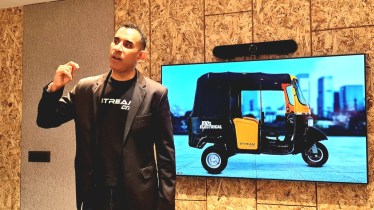Two reasons why electric mobility is something to consider: Running costs and environmental concerns. The energetic founder of Omega Seiki Mobility, Uday Narang, says increasingly smaller towns and cities are looking towards greener and cheaper forms of mobility, and that is where electric vehicle companies should focus. “Real scale will come in tier-3 and tier-4 cities,” Narang said during the launch of the company’s latest electric three-wheeler, the OSM Stream.
Omega Seiki Mobility (OSM) is looking to rapidly expand its dealer network and much of this expansion will happen in smaller towns and cities, hoping to tap into demand there. The company currently has 178 dealers which it is looking to scale up to 300 by the end of calendar year 2023.
It has three factories in Faridabad that make its three-wheelers and two-wheelers and one in Pune, and it’s looking to add one in South India as well. The company is in talks with the governments of Tamil Nadu, Karnataka and Telangana for its next facility. It is also in the process of raising funds, having largely been bootstrapped till now.
Why tier-3 and tier-4 locations?
Narang says Indians are always looking for ways to save cost. Be it running cost, cost of purchase or just getting more bang for the buck. As an example, he cites how autorickshaws rated for 3 passengers and 1 driver are usually seen carrying way more than specified especially in rural areas. These places are highly cost-conscious and will look at multiple ways to save money, be it over-loading or minimising downtime.
“If you can convince a driver that by going electric, they will be saving a substantial amount of money, you will get their attention,” says Narang. In keeping with that thought, the company is launching two versions of its Stream three-wheeler, one with swappable batteries (in a tie-up with Sun Mobility) and one with a fixed battery set-up, which offers rapid charging. The former is priced at Rs 1.85 lakh ex-showroom, while the latter is at Rs 3.01 lakh (with the battery making up a large chunk of the cost).
That’s just a part of the plan. The long-term plans for OSM include venturing into 1-ton and 3-ton trucks (under the brand M1KA). It has already imported several of these trucks, which will cater to intra-city delivery fleets, and will soon venture into assembling them locally. In fact, it has tie-ups with logistics firms who have picked up these trucks to effect last-mile deliveries, besides the cargo three-wheeler fleet (Rage+) that it already has in the market.
This last-mile cargo space is seeing increasing interest in going electric. Companies such as Mahindra and Tata are already in this space with electric three-wheelers and four-wheelers respectively. And there are many younger startups such as Euler, Altigreen and others also with competing products. However, most of these are concentrated around metros, while OSM wants to take the lead in smaller towns with its passenger three-wheelers, while many players are already offering electric two-wheelers in these markets. So, the concept of an EV isn’t novel anymore here.OSM sold 2,931 EVs in domestic sales in 2022, while it exported another 3,000 odd. It has a target to sell 14,000 EVs in 2023. By 2025, the company expects to sell 40,000 EVs a year, and it sees a large part of this growth coming from smaller cities and towns.
